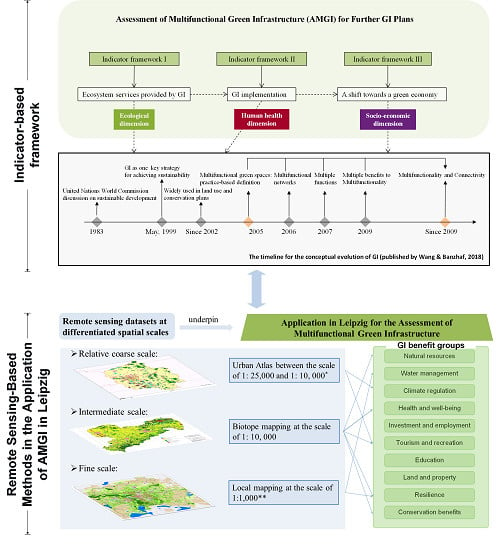An Integrated Indicator Framework for the Assessment of Multifunctional Green Infrastructure—Exemplified in a European City
Abstract
1. Introduction
2. Materials
2.1. Selected Indicator Frameworks for AMGI
2.2. Remote Sensing Techniques as Essential Pillars for AMGI
2.3. Earth Observation Datasets for the Exemplification in Leipzig, Germany
- (1)
- The land-cover data originated from the European Urban Atlas land cover dataset—Copernicus Land Monitoring Service [50]. It was obtained from the European Environment Agency (EEA, http://www.eea.europa.eu/data-and-maps/data/urban-atlas). For the first time slot, Urban Atlas data (2006) [1] conveys 305 larger urban zones (including commuting zones around cities) in the 27 countries of the EU for all the European core cities and respective larger urban zones with more than 100,000 inhabitants. Its products are combined image classifications with 20 m (shot-wave-infrared (SWIR) mode) to 10 m (near-infrared (NIR) and visible spectral) multispectral analysis for urban GI, being pan-sharpened to 5 m to 2.5 m spatial resolutions. The more recent slot, i.e., UA data for 2012, covers all European cities with a minimum of 50,000 inhabitants. Our application in Leipzig used the Urban Atlas data from 2012 [50].
- (2)
- The Leipzig biotope mapping (2005) [51] extracted from the biotope map of Saxony. It is similarly structured to the Urban Atlas, as it includes both human-built classes as well as natural and semi-natural classes [51]. However, the data set is derived from 1:10,000 color-infrared orthophotos by the manual classification of biotopes with a minimal area of 0.25 ha [51]. This thematic information was produced by the “Sächsisches Landesamt für Umwelt Landwirtschaft und Geologie” (2008) [51]. Its classification system of biotope types gives abundant information on diversified sites and biotopes in urban areas [48]. Biotope mapping characterizes cities, especially urban areas, as a complex habitat mosaic [52], which are made up of various sub-units and forms. They are major components of our evaluating objects. This premise permits that its classification of urban spatial categories and matrix-patches mapping [53] may extensively facilitate the identification of several GI features such as deciduous forests and zoological gardens; whereas other datasets like Corine Land Cover cannot provide sufficient information on urban GI, due to their coarse spatial resolution or relatively rough taxonomy.
- (3)
- The local Land Use and Land Cover (LULC) structural analysis for Leipzig in the year of 2012 [54,55]. To gain the spatial information on urban LULC at a very high resolution, we employed four-band color infrared digital orthophotos (DOP), a digital elevation model (DEM), and a digital surface model (DSM). These datasets were processed by an Object-based Image Analysis (OBIA) approach. The complex methodology of this OBIA mapping process is depicted by Banzhaf et al. [43,54], in which the different datasets were all rescaled to 1 m ground resolution for the year 2012. As for the demographic data, we employed the population data for 2012 collected by the city council [56], which includes all urban residents with their first and second place of residency in Leipzig. By including those with a second residency, we also pay tribute to international students, commuters, etc., which best generates a picture of the real users. The respective usages of the three aforementioned earth observation datasets can be also found in following Table 2 (see Section 3.3).
3. Methods
3.1. Analysis Method for Selected Indicator Frameworks
3.2. Methodology Application of the Indicator Framework for AMGI
- (1)
- Stage 1: for priority setting, there are needs for addressing multifunctionality and the multi-dimensions of sustainability.
- (2)
- Stage 2: for contextual assessment, there are needs to frame the indicator selection
- (3)
- Stage 3: for retrospective assessment, there are five major elements/components being advised to be evaluated again to exploit the multifunctionality of GI in depth.
3.3. Remote Sensing-Based Methods in the Application in Leipzig
4. Results
4.1. Multi-Dimensional Analysis of Indicator Frameworks I–III Towards Sustainability
4.1.1. Indicator Framework I for ESS Assessment from MAES
4.1.2. Indicator Framework II for GI Implementation from IEEP
4.1.3. Indicator Framework III Supporting a Shift towards a Green Economy from EMDA
4.2. Integrated Indicator Framework for AMGI
4.3. Exemplification of an Assessment of Multifunctional Green Infrastructure (AMGI)
- (1)
- Stage 1: The needs for addressing multifunctionality and multi-dimensions of sustainability.
- (2)
- Stage 2: Contextual assessment in the City of Leipzig, Germany
- (3)
5. Discussion
5.1. Evaluation of Our Integrated Indicator Framework
5.2. Implications from the AMGI Exemplified in One European City, Leipzig
5.3. Application Potential of Our Integrated Indicator Framework and Methodology
5.4. Improving the Integrated Framework on AMGI and Its Limitations
6. Conclusions
Supplementary Materials
Author Contributions
Funding
Acknowledgments
Conflicts of Interest
Appendix A
- Table A1: Indicator framework I for ESS assessment from MAES classified in terms of four dimensions.
- Table A2: Indicator framework II for GI implementation from IEEP classified in terms of four dimensions.
- Table A3: Indicator framework III for a shift towards green economy from EMDA classified in terms of four dimensions.
Appendix A.1. Indicator Framework I for ESS Assessment from Commong International Classification of Ecosystem Services (CICES) and Mapping and Assessment Ecosystem Services (MAES)
| Code No. (00) for Indicator Framework I | Indicators Adapted from CICES & MAES | Ecology | Socio-Economy (SE) | Socio-Culture (SC) | Human Health (HH) |
|---|---|---|---|---|---|
| Provisioning | |||||
| 01 | Production of food (ton ha−1 year−1) | ||||
| 02 | Surface of community gardens /small plots for self-consumption (ha) | ||||
| 03 | Drinking water provision (m3 ha−1 year−1) | ||||
| 04 | Drinking water consumption (m3 year−1) | ||||
| 05 | Water provision (m3 ha−1 year−1) | ||||
| 06 | Water consumption per sector (m3 year−1) | ||||
| Regulation and Maintenance | |||||
| 07 | Pollutants removed by vegetation (in leaves, stems and roots) (kg ha−1 year−1) | ||||
| 08 | Dry deposition velocity (mm s−1) | ||||
| 09 | Population exposed to high concentrations of pollutants (% on surface area) | ||||
| 10 | Carbon storage in soil (ton C ha−1) | ||||
| 11 | Carbon sequestration (ton ha−1 year−1) | ||||
| 12 | Leaf Area Index | ||||
| 13 | Temperature decrease by tree cover (°C m−2) | ||||
| 14 | Cooling capacity of urban green trees | ||||
| 15 | Cooling capacity of UGI | ||||
| 16 | Cooling capacity of urban green spaces | ||||
| 17 | Population exposed to high temperatures (% per unit area) | ||||
| 18 | Leaf Area Index + distance to roads (m) | ||||
| 19 | Noise reduction rates applied to UGI within a defined road buffer dB(A) m−2 vegetation unit | ||||
| 20 | Soil water storage capacity (mm) | ||||
| 21 | Soil water infiltration capacity (cm) | ||||
| 22 | Water retention capacity by vegetation and soil (ton km−2) | ||||
| 23 | Intercepted rainfall (m3 year−1) | ||||
| 24 | Surface runoff (mm) | ||||
| 25 | Share of green areas in zones in danger of floods (%) | ||||
| 26 | Population exposed to flood risk (% per unit area) | ||||
| 27 | Areas exposed to flooding (ha) | ||||
| 28 | Capacity of ecosystems to sustain insect pollinators activity (dimensionless) | ||||
| 29 | Relative abundance (number over area or over a length) | ||||
| Cultural | |||||
| 30 | Accessibility to public parks, gardens and play-grounds (more than 50 ha)—(inhabitants within 10 km from a park) | ||||
| 31 | Accessibility to public parks gardens and play-grounds (between 10 ha and 50 ha)—(inhabitants within 1 km from a park) | ||||
| 32 | Accessibility to public parks gardens and play-grounds (between 2.5 ha and 10 ha)—(inhabitants within 500 m from a park) | ||||
| 33 | Accessibility to public parks gardens and play-grounds (between 0.75 ha and 2.5 ha or smaller but important green spaces)—(inhabitants within 250 m from a park). | ||||
| 34 | Weighted recreation opportunities provided by Urban Green Infrastructure | ||||
| 35 | Nature-based recreation opportunities (includes Natura 2000; includes bathing water quality) (dimensionless) | ||||
| 36 | Proximity of green infrastructure to green travel routes (km) | ||||
| 37 | Green related social service provided to population (dimensionless) | ||||
| 38 | Regression models of ES hotspots and cold spots based on georeferenced data (i.e., pictures or geo tagged locations) | ||||
| 39 | Accessibility of parks from schools (number of public parks and gardens within a defined distance from a school) | ||||
| 40 | Cultural and natural heritage sites (e.g., United Nations Educational, Scientific, Cultural Organization (UNESCO) world heritage sites) (number per unit area, % per unit area) | ||||
| In sum | Count | 26 | 5 | 12 | 7 |
| Percentage | 52% | 10% | 24% | 14% | |
Appendix A.2. Indicator Framework II for GI Implementation from Institute for European Environmental Policy (IEEP)
| Code No.(0000) for Indicator Framework II | GI Functional Indicators | Ecology | Socio-Economy (SE) | Socio-Culture (SC) | Human Health (HH) |
|---|---|---|---|---|---|
| Natural resources | |||||
| 0001 | Forests for wood supply | ||||
| 0002 | Total area of cropland/grassland suitable for livestock | ||||
| 0003 | Total area of low input cropland | ||||
| 0004 | Soil carbon content | ||||
| 0005 | Species composition, aggregated in functional groups (e.g., biomass of decomposers, proportion of different trophic groups) as an indicator of process capability | ||||
| 0006 | Abundance and species richness of biological control agents (e.g., predators, insects, etc.) | ||||
| 0007 | Changes in disease burden as a result of changing ecosystems | ||||
| 0008 | Range of biological control agents (e.g., in km, regular/aggregated/random, per species) | ||||
| 0009 | Abundance and species richness of wild pollinators | ||||
| 0010 | Range of wild pollinators (e.g., in km, regular/aggregated/random, per species) | ||||
| 0011 | Proximity to natural habitat for pollination | ||||
| 0012 | Groundwater recharge | ||||
| 0013 | Total area of inland water bodies and inland wetlands | ||||
| Water management | |||||
| 0014 | Water infiltration capacity/rate | ||||
| 0015 | Water storage capacity in mm/m | ||||
| 0016 | Floodplain water storage capacity in mm/m | ||||
| 0017 | Water quality in aquatic ecosystems (sediment, turbidity, phosphorous, nutrients, etc.) | ||||
| 0018 | Biological indicators: e.g., index of biological integrity | ||||
| 0019 | Nitrogen retention | ||||
| 0020 | Nitrogen removal | ||||
| Climate regulation | |||||
| 0021 | Total amount of carbon sequestered/stored=sequestration/storage capacity per hectare * total area (GtCO2) | ||||
| 0022 | Evapotranspiration rate | ||||
| 0023 | Canopy stomatal conductance | ||||
| 0024 | Wind attenuation potential | ||||
| Health and well-being | |||||
| 0025 | Atmospheric cleansing capacity in tons of pollutants removed per hectare | ||||
| 0026 | Downward pollutant flux, calculated as the product of dry deposition velocity and pollutant concentration | ||||
| 0027 | Reduced stress levels and improving mental health | ||||
| 0028 | Increased physical activities | ||||
| 0029 | Natural sound absorption capacity | ||||
| Investment and employment | |||||
| 0030 | Scenery, amenity, environmental quality | ||||
| 0031 | Employment resulting from GI initiatives | ||||
| 0032 | Amount of workplace individuals benefiting from GI investment or existing GI | ||||
| Tourism and recreation | |||||
| 0033 | Scenery, amenity, environmental quality, products, flagship species, and habitats | ||||
| 0034 | Exercise, scenery, amenity for public recreation | ||||
| Education | |||||
| 0035 | Educational visits: flagship species and habitats, endemic species | ||||
| Land and property | |||||
| 0036 | Exercise, scenery, amenity for up valuation of individual property | ||||
| Resilience | |||||
| 0037 | Particular emphasis on regulating and supporting services | ||||
| Conservation benefits | |||||
| 0038 | Existence value of habitat, species, and genetic diversity | ||||
| 0039 | Bequest and altruist value of habitat, species, and genetic diversity for future generations | ||||
| In sum | Count | 26 | 12 | 7 | 13 |
| Percentage | 45% | 21% | 12% | 22% | |
Appendix A.3. Indicator Framework III Supporting A Shift Towards Green Economy from East Midlands Development Agency (EMDA)
| Code No.(00000) for Indicator Framework III | Indicators for GI Quantitative Benefits | Ecology | Socio-Economy (SE) | Socio-Culture (SC) | Human Health (HH) |
|---|---|---|---|---|---|
| Natural resources | |||||
| 00001 | Production of food in tons, m3 and/or hectares | ||||
| 00002 | Quantity of certified production of food | ||||
| 00003 | Number of wild species used as food/ornamental resources etc. | ||||
| 00004 | Employment sustained by agricultural sectors | ||||
| 00005 | Increased yield attributable to soil quality | ||||
| 00006 | Increased yield attributable to biological control | ||||
| 00007 | Increased yield attributable to pollination | ||||
| 00008 | Population served by renewable water resource | ||||
| 00009 | Total annual freshwater consumption by sector | ||||
| Water management | |||||
| 00010 | Deprived households at risk of flooding | ||||
| 00011 | Reduced surface water run-off | ||||
| 00012 | Population served by high water quality | ||||
| Climate regulation and adaption | |||||
| 00013 | Total amount of carbon removed and contribution to the achievement of climate change targets | ||||
| 00014 | Reduced peak summer surface temperatures | ||||
| 00015 | Building energy savings—heating and cooling | ||||
| 00016 | Deprived households at risk of storm damage | ||||
| 00017 | Deprived land at risk of storm damage | ||||
| Health and well-being | |||||
| 00018 | Total amount of pollutants removed and contribution to air quality targets | ||||
| 00019 | Human health impacts expressed in disability adjusted life years (Daily = years of life lost + years lived with disability) | ||||
| 00020 | Persons/year where defined threshold in dB is not exceeded due to natural sound absorbers | ||||
| Investment and employment | |||||
| 00021 | Perception surveys on the attractiveness of an area for workers/investors | ||||
| 00022 | Number of products whose branding relates to cultural identity | ||||
| 00023 | Temporary employment impacts of GI provision | ||||
| 00024 | Ongoing employment impacts of maintenance | ||||
| 00025 | Summary of employment sustained by sectors (e.g., agriculture, forestry, tourism and recreation | ||||
| 00026 | Impact on workers’ effectiveness on the job | ||||
| Tourism and recreation | |||||
| 00027 | Employment supported by tourism | ||||
| 00028 | Amount of nature tourism | ||||
| 00029 | Number of visitors to protected sites per year | ||||
| 00030 | Number of local users for hiking, camping, nature walks jogging, winter sports, water sports, angling, horse riding, hunting, cycling | ||||
| Education | |||||
| 00031 | Total number of visits, specially related to education or cultural reasons | ||||
| 00032 | Total number of educational excursions | ||||
| 00033 | Number of TV programs, studies, books, etc. featuring sites and the surrounding area | ||||
| Land and property | |||||
| 00034 | Residential land and property value uplift (1 km from green space) | ||||
| 00035 | Commercial land/property value uplift (1 km from green space) | ||||
| Resilience | |||||
| 00036 | Scoring according to portfolio of services and functions provided | ||||
| Conservation benefits | |||||
| 00037 | Non-use benefits estimated by contingent valuation method or choice experiment | ||||
| n sum | Count | 19 | 23 | 13 | 11 |
| Percentage | 29% | 35% | 20% | 17% | |
Appendix B
| The Gray to Green Continuum | Human Influence/Association with Green Infrastructure (GI) | Class Number | GI Classes | Type Number | GI Types/Ecosystem Service Unit | Analyzed GI Types in Our AMGI (YES/NO) |
|---|---|---|---|---|---|---|
 | Associated to GI | 01 | blue spaces | |||
| 001 | water course | YES | ||||
| 002 | water body | YES | ||||
| 003 | estuary | NO | ||||
| 004 | delta | NO | ||||
| 005 | sea coast | NO | ||||
| Heterogeneous cultivation—biotic | 02 | arable land | ||||
| 006 | arable land | YES | ||||
| 007 | bioenergy agriculture/agroforestry | YES | ||||
| 03 | grassland | |||||
| 008 | pasture | YES | ||||
| 009 | heathland | NO | ||||
| 010 | moorland | YES | ||||
| 04 | orchard | |||||
| 011 | tree meadow/meadow orchard | YES | ||||
| 012 | horticulture | YES | ||||
| 05 | forest | |||||
| 013 | managed forest, deciduous and coniferous | YES | ||||
| 014 | woodland (low-density forest forming open habitats) | YES | ||||
| 06 | shrubland | |||||
| 015 | vegetation dominated by shrubs, including grasses, herbs | YES | ||||
| natural, semi-natural areas—biotic | 07 | Private gardens | ||||
| 016 | front and backyard garden | NO | ||||
| 08 | River-related green | |||||
| 017 | riverbank green | YES | ||||
| 09 | Wetlands | 018 | fen, marsh, bog and wet flush vegetation | YES | ||
| 10 | parks or public green spaces | |||||
| 019 | large central park (historical park) | YES | ||||
| 020 | pocket park | YES | ||||
| 021 | botanical garden | YES | ||||
| 022 | zoological garden | YES | ||||
| 023 | neighborhood green space | YES | ||||
| 024 | institutional green space | NO | ||||
| 025 | cemetery and churchyard | YES | ||||
| 026 | sport and leisure facility | YES | ||||
| 027 | campsite | YES | ||||
| 11 | allotments and community gardens | |||||
| 028 | community garden (tended collectively by a group of people on private or public land) | YES | ||||
| 029 | allotment (small plots for individuals which collectively make up a larger green space) | YES | ||||
| Man-made biotic close to gray infrastructure | 12 | building greens | ||||
| 030 | balcony green | NO | ||||
| 031 | ground-based green wall | NO | ||||
| 032 | façade-bound green wall | NO | ||||
| 033 | extensive green roof | NO | ||||
| 034 | intensive green roof | NO | ||||
| 035 | atrium | NO | ||||
| 13 | commercial, industrial, institutional urban green space (UGS) and UGS connected to gray infrastructure | |||||
| 036 | bioswale | NO | ||||
| 037 | rain garden | YES | ||||
| 038 | railroad bank | NO | ||||
| 039 | playground, school grounds | YES | ||||
| 040 | ruderal area | YES | ||||
| 14 | Street trees | |||||
| 041 | tree alley, street tree, aligned hedge | YES | ||||
| natural, semi-natural areas—abiotic | 15 | Natural abiotic surface | ||||
| 042 | rock | NO | ||||
| 043 | sand dune | NO | ||||
| Not—GI | 16 | Human-induced abiotic surface | ||||
| 044 | sealed surface, impervious surface, built-up area | NO | ||||
| 045 | derelict land/abandoned area | NO | ||||
| 046 | sand pit, quarry, open cast mine | NO |
References
- European Environment Agency (EEA). Green Infrastructure and Territorial Cohesion. The Concept of Green Infrastructure and Its Integration into Policies Using Monitoring Systems; Technical Report 18; European Environment Agency: Copenhagen, Denmark, 2011; Available online: http://www.eea.europa.eu/publications/green-infrastructure-and-territorial-cohesion (accessed on 5 December 2016).
- Mazza, L.; Bennett, G.; De Nocker, L.; van Diggelen, R. Green infrastructure implementation and efficiency, Final Report for the European Commission, DG Environment on Contract ENV.B.2/SER/2010/0059; Institute for European Environmental Policy: Brussels, Belguim; London, UK, 2011. [Google Scholar]
- European Commission (EC). The Multifunctionality of Green Infrastructure. In Science for Environment Policy. In Depth Reports. March 2012. Available online: https://ec.europa.eu/environment/nature/ecosystems/docs/Green_Infrastructure.pdf (accessed on 20 February 2017).
- Wang, J.; Banzhaf, E. Towards a better understanding of Green Infrastructure: A critical review. Ecol. Indic. 2018, 85, 758–772. [Google Scholar] [CrossRef]
- Firehock, K. A Short History of the Term Green Infrastructure and Selected Literature. Available online: http://www.gicinc.org/PDFs/GI%20History.pdf.ed (accessed on 30 August 2018).
- Davies, C.; Hansen, R.; Rall, E.; Pauleit, S.; Lafortezza, R.; DeBellis, Y.; Santos, A.; Tosics, I. Green Infrastructure Planning and Implementation (GREEN SURGE). The Status of European Green Space Planning and Implementation Based on an Analysis of Selected European City-Regions, FP7-ENV.2013.6.2-5-603567; 2013-2017; Copenhagen, Denmark, 2015; 1–134. [CrossRef]
- Wang, J.; Xu, C.; Pauleit, S.; Kindler, A.; Banzhaf, E. Spatial patterns of urban green infrastructure for equity: A novel exploration. J. Clean Prod. 2019, 117858. [Google Scholar] [CrossRef]
- Hansen, R.; Rolf, W.; Santos, A.; Luz, A.; Száraz, L.; Tosics, I.; Vierikko, K.; Rall, E.; Davies, C.; Pauleit, S. Advanced urban green infrastructure planning and implementation: Innovative approaches and Strategies from European cities. Green Surge Proj. Deliv. Available online: https://greensurge.eu/ (accessed on 12 May 2018).
- Breuste, J.; Artmann, M.; Li, J.X.; Xie, M.M. Special Issue on Green Infrastructure for Urban Sustainability. J. Urban Plan. Dev. 2015, 141, 3. [Google Scholar] [CrossRef]
- Artar, M.; Gormus, S.; Cengiz, S. Landscape Assessments in Bartin (Tr) Via Green Infrastructure Approach. J. Environ. Prot. Ecol. 2016, 172, 737–746. [Google Scholar]
- Barau, A.S. Perceptions and contributions of households towards sustainable urban green infrastructure in Malaysia. Habitat. Int. 2015, 47, 285–297. [Google Scholar] [CrossRef]
- Meerow, S.; Newell, J.P. Spatial planning for multifunctional green infrastructure: Growing resilience in Detroit. Landsc. Urban Plan. 2017, 159, 62–75. [Google Scholar] [CrossRef]
- United Nations. Indicators of Sustainable Development: Framework and Methodologies; United Nations: New York, NY, USA, 1996. [Google Scholar]
- McDonald, L.; Allen, W.; Benedict, M.; O’connor, K. Green infrastructure plan evaluation frameworks. J. Conserv. Plan. 2005, 1, 12–43. [Google Scholar]
- Wright, H. Understanding green infrastructure: The development of a contested concept in England. Local Env. 2011, 16, 1003–1019. [Google Scholar] [CrossRef]
- Maes, J.; Teller, A.; Erhard, M.; Liquete, C.; Braat, L.; Berry, P.; Egoh, B.; Puydarrieux, P.; Fiorina, C.; Santos-Martín, F. Mapping and Assessment of Ecosystems and their Services—An. Analytical Framework for Ecosystem Assessments Under Action 5 of the EU Biodiversity Strategy to 2020; Publications Office of the European Union: Brussels, Belgium, 2013. [Google Scholar]
- Maes, J.; Liquete, C.; Teller, A.; Erhard, M.; Paracchini, M.L.; Barredo, J.I.; Grizzetti, B.; Cardoso, A.; Somma, F.; Petersen, J.E.; et al. An indicator framework for assessing ecosystem services in support of the EU Biodiversity Strategy to 2020. Ecosyst. Serv. 2016, 17, 14–23. [Google Scholar] [CrossRef]
- Maes, J.; Teller, A.; Erhard, M.; Murphy, P.; Paracchini, M.L.; Barredo, J.I.; Grizzetti, B.; Cardoso, A.; Somma, F.; Petersen, J.E. Mapping and Assessment of Ecosystems and their Services: Indicators for ecosystem assessments under Action 5 of the EU Biodiversity Strategy to 2020; Publications Office of the European Union: Brussels, Belgium, 2014. [Google Scholar]
- Naumann, S.; Davis, M.; Kaphengst, T.; Pieterse, M.; Rayment, M. Design, Implementation and Cost Elements of Green Infrastructure Projects; Final Report; European Commission: Brussels, Belgium, 2011; p. 138. [Google Scholar]
- Zhang, Z.; Meerow, S.; Newell, J.P.; Lindquist, M. Enhancing landscape connectivity through multifunctional green infrastructure corridor modeling and design. Urban For. Urban Green. 2019, 38, 305–317. [Google Scholar] [CrossRef]
- Pauleit, S.; Andersson, E.; Anton, B.; Buijs, A.; Haase, D.; Hansen, R.; Kowarik, I.; Stahl Olafsson, A.; Van der Jagt, S. Urban green infrastructure–connecting people and nature for sustainable cities. Urban For. Urban Green. 2019. [Google Scholar] [CrossRef]
- Maes, J.; Teller, A.; Erhard, M.; Liquete, C.; Braat, L.; Berry, P.; Egoh, B.; Puydarrieux, P.; Fiorina, C.; Santos-Martín, F. Mapping and Assessment of Ecosystems and their Services-Urban Ecosystems; 4th Report; Publications Office of the European Union: Brussels, Belgium, 2016. [Google Scholar]
- Gordon, B.L.; Quesnel, K.J.; Abs, R.; Ajami, N.K. A case-study based framework for assessing the multi-sector performance of green infrastructure. J. Environ. Manag. 2018, 223, 371–384. [Google Scholar] [CrossRef] [PubMed]
- Niemeijer, D.; de Groot, R.S. A conceptual framework for selecting environmental indicator sets. Ecol. Indic. 2008, 8, 14–25. [Google Scholar] [CrossRef]
- Cordier, M.; Agundez, J.A.P.; Hecq, W.; Hamaide, B. A guiding framework for ecosystem services monetization in ecological-economic modeling. Ecosyst. Serv. 2014, 8, 86–96. [Google Scholar] [CrossRef]
- East Midlands Development Agency. A Guide and Toolkit Green Infrastructure: Playind an Important Role in Achieving Sustainable Economic Growth; East Midlands Development Agency: Nottingham, UK, 2010. [Google Scholar]
- Haines-Young, R.; Potschin, M. The links between biodiversity, ecosystem services and human well-being. Ecosyst. Ecol. A New Synth. 2010, 110–139. [Google Scholar] [CrossRef]
- Rocha, S.M.Z.; Maes, J.; Thijssen, M. Mapping and Assessment of Ecosystems and their Services; Publications Office of the European Union: Brussels, Belgium, 2015; Volume 5, pp. 1–58. [Google Scholar]
- TEEB. Mainstreaming the Economics of Nature: A Synthesis of the Approach, Conclusions and Recommendations of TEEB; United Nations Environment Programme: Nairobi, Kenya, 2010. [Google Scholar]
- Reid, W.R.; Monney, H.A.; Cropper, A.; Capistrano, D.; Carpenter, S.R.; Chopra, K. Millennium Ecosystem Assessment, Ecosystems and Human Well-Being: Synthesis; Island Press: Washington, DC, USA, 2005. [Google Scholar]
- Vandermeulen, V.; Verspecht, A.; Vermeire, B.; Van Huylenbroeck, G.; Gellynck, X. The use of economic valuation to create public support for green infrastructure investments in urban areas. Lands. Urban Plan. 2011, 103, 198–206. [Google Scholar] [CrossRef]
- Ten Brink, B.; Tekelenburg, T. Biodiversity: How much is Left? The Natural Capital Index Framework; National Institute for Public Health and the Environment: Bilthoven, The Netherlands, 2002. [Google Scholar]
- Pauleit, S.; Ambrose-Oji, B.; Andersson, E.; Anton, B.; Buijs, A.; Haase, D.; Elands, B.; Hansen, R.; Kowarik, I.; Kronenberg, J.; et al. Advancing urban green infrastructure in Europe: Outcomes and reflections from the GREEN SURGE project. Urban For. Urban Green. 2019, 40, 4–16. [Google Scholar] [CrossRef]
- Green Infrastructure North West. Building Natural Value for Sustainable Economic Development: The Green Infrastructure Valuation Toolkit User Guide. Available online: http://www.greeninfrastructurenw.co.uk/resources/Green_Infrastructure_Valuation_Toolkit_UserGuide.pdf (accessed on 30 May 2018).
- Madad, A.; Gharagozlou, A.; Majedi, H.; Monavari, S. A quantitative representation of the urban green building model, focusing on local climatic factors by utilizing monetary valuation. Ecol. Econ. 2019, 161, 61–72. [Google Scholar] [CrossRef]
- Hansen, R.; Frantzeskaki, N.; McPhearson, T.; Rall, E.; Kabisch, N.; Kaczorowska, A.; Kain, J.-H.; Artmann, M.; Pauleit, S. The uptake of the ecosystem services concept in planning discourses of European and American cities. Ecosyst. Serv. 2015, 12, 228–246. [Google Scholar] [CrossRef]
- Rall, E.L.; Kabisch, N.; Hansen, R. A comparative exploration of uptake and potential application of ecosystem services in urban planning. Ecosyst. Serv. 2015, 16, 230–242. [Google Scholar] [CrossRef]
- Nielsen, A.B.; Hedblom, M.; Olafsson, A.S.; Wiström, B. Spatial configurations of urban forest in different landscape and socio-political contexts: Identifying patterns for green infrastructure planning. Urban Ecosyst. 2016, 1–14. [Google Scholar] [CrossRef]
- Herzog, C.P. A multifunctional green infrastructure design to protect and improve native biodiversity in Rio de Janeiro. Landsc. Ecol. Eng. 2016, 12, 141–150. [Google Scholar] [CrossRef]
- Fish, R.; Church, A.; Willis, C.; Winter, M.; Tratalos, J.A.; Haines-Young, R.; Potschin, M. Making space for cultural ecosystem services: Insights from a study of the UK nature improvement initiative. Ecosyst. Serv. 2016, 21, 329–343. [Google Scholar] [CrossRef]
- Mell, I. Global green infrastructure: Lessons for successful policy-making, investment and management; Routledge: London, UK, 2016. [Google Scholar]
- Kronenberg, J.; Andersson, E. Integrated Valuation: Integrating Value Dimensions and Valuation Methods. GREEN SURGE project (Milestone MS32). Available online: https://greensurge.eu/ (accessed on 12 May 2018).
- Wang, J.; Banzhaf, E. Derive an Understanding of Green Infrastructure for the Quality of Life in Cities by Means of Integrated RS Mapping Tools. In Proceedings of the Urban Remote Sensing Event, Joint 2017, Dubai, UAE, 6–8 March 2017. [Google Scholar] [CrossRef]
- Hong, S.-K.; Song, I.-J.; Byun, B.; Yoo, S.; Nakagoshi, N. Applications of biotope mapping for spatial environmental planning and policy: Case studies in urban ecosystems in Korea. Landsc. Ecol. Eng. 2005, 1, 101–112. [Google Scholar] [CrossRef]
- Mansuroglu, S.; Ortacesme, V.; Karaguzel, O. Biotope mapping in an urban environment and its implications for urban management in Turkey. J. Environ. Manag. 2006, 81, 175–187. [Google Scholar] [CrossRef] [PubMed]
- Zhao, Z.-b.; Xue, L.; Zhang, J.; WEI, H.-Y. Urban Biotope Mapping and Nature Conservation Planning in Typical Area of Xi’an City of China. Sci. Geogr. Sin. 2007, 27, 561. (In Chinese) [Google Scholar]
- Elvenes, S.; Dolan, M.F.; Buhl-Mortensen, P.; Bellec, V.K. An evaluation of compiled single-beam bathymetry data as a basis for regional sediment and biotope mapping. ICES J. Mar. Sci. 2013, 71, 867–881. [Google Scholar] [CrossRef]
- Werner, P.; Zahner, R. Urban patterns and biological diversity: A review. Urban Biodivers. Des. 2010, 145. [Google Scholar] [CrossRef]
- Grunewald, K.; Syrbe, R.U.; Bastian, O. Landscape management accounting as a tool for indicating the need of action for ecosystem maintenance and restoration - Exemplified for Saxony. Ecol. Indic. 2014, 37, 241–251. [Google Scholar] [CrossRef]
- European Environment Agency (EEA). Global Monitoring for Environment and Security (GMES): Copernicus Land Monitoring Service: Urban Atlas data. 2017. Available online: https://www.eea.europa.eu/data-and-maps/data/copernicus-land-monitoring-service-urban-atlas#tab-gis-data (accessed on 17 May 2018).
- Sächsisches Landesamt für Umwelt Landwirtschaft und Geologie. (CIR Biotope Type and Land-Use Map Saxony 2005) CIR-Biotoptypen-und Landnutzungskartierung Sachsen 2005. 2008. (In German)
- Mazerolle, M.J.; Villard, M.-A. Patch characteristics and landscape context as predictors of species presence and abundance: A review 1. Écoscience 1999, 6, 117–124. [Google Scholar] [CrossRef]
- Mathieu, R.; Freeman, C.; Aryal, J. Mapping private gardens in urban areas using object-oriented techniques and very high-resolution satellite imagery. Landsc. Urban Plan. 2007, 81, 179–192. [Google Scholar] [CrossRef]
- Banzhaf, E.; Kollai, H.; Kindler, A. Mapping urban grey and green structures for liveable cities using a 3D enhanced OBIA approach and vital statistics. Geocarto Int. 2018, 1–18. [Google Scholar] [CrossRef]
- Banzhaf, E.; Kollai, H. Land Use/Land Cover for Leipzig, Germany, for 2012 by an Object-Based Image Analysis. PANGAEA 2018. [Google Scholar] [CrossRef]
- Stadt Leipzig, Statistics: Willkommen beim Leipzig-Informationssystem. Available online: https://statistik.leipzig.de/ (accessed on 5 March 2019).
- Haines-Young, R.; Potschin, M.B. Common International Classification of Ecosystem Services (CICES) V5.1 and Guidance on the Application of the Revised Structure. European Environment Agency (EEA). Available online: https://cices.eu/ (accessed on 7 June 2018).
- Kabisch, N.; Strohbach, M.; Haase, D. Internal Project Report on Inventory of Urban Green Space Demand for the Two Scale Levels, ULLS and European Urban Atlas Cities. 2015; p. 16. Available online: https://greensurge.eu/ (accessed on 12 May 2018).
- Peng, J.; Hu, X.; Qiu, S.; Hu, Y.; Meersmans, J.; Liu, Y. Multifunctional landscapes identification and associated development zoning in mountainous area. Sci. Total Environ. 2019, 660, 765–775. [Google Scholar] [CrossRef] [PubMed]
- Willemen, L.; Hein, L.; Van Mensvoort, M.E.; Verburg, P.H. Space for people, plants, and livestock? Quantifying interactions among multiple landscape functions in a Dutch rural region. Ecol. Indic. 2010, 10, 62–73. [Google Scholar] [CrossRef]
- Chainey, S. Advanced Hotspot Analysis: Spatial Significance Mapping Using Gi*; UCL Jill Dando Institute of Crime Science, University College London: London, UK, 2010. [Google Scholar]
- Manepalli, U.R.; Bham, G.H.; Kandada, S. Evaluation of hotspots identification using kernel density estimation (K) and Getis-Ord (Gi*) on I-630. In Proceedings of the 3rd International Conference on Road Safety and Simulation, Indianapolis, IN, USA, 14–16 September 2011; pp. 14–16. [Google Scholar]
- Getis, A.; ORD, J. The analysis of spatial association by use of distance statistics. Geogr. Anal. 1992, 24, 189–206. [Google Scholar] [CrossRef]
- Poelman, H. A Walk to the Park? Assessing Access to Green Areas in Europe’s Cities. 2018. Available online: https://ec.europa.eu/regional_policy/sources/docgener/work/2016_03_green_urban_area.pdf (accessed on 17 October 2018).
- Schwarz, N.; Schlink, U.; Franck, U.; Grossmann, K. Relationship of land surface and air temperatures and its implications for quantifying urban heat island indicators—An application for the city of Leipzig, Germany. Ecol. Indic. 2012, 18, 693–704. [Google Scholar] [CrossRef]
- Priess, J.; Elger, R.; Hauck, J. The ESM-App–A New Smartphone Application to Map Ecosystem Services. In Proceedings of the 7th International Congress on Environmental Modelling and Software, San Diego, CA, USA, 15–19 June 2014; pp. 15–19. [Google Scholar]
- Strohbach, M.W.; Haase, D. Above-ground carbon storage by urban trees in Leipzig, Germany: Analysis of patterns in a European city. Landsc. Urban Plan. 2012, 104, 95–104. [Google Scholar] [CrossRef]
- Derkzen, M.L.; van Teeffelen, A.J.A.; Verburg, P.H. Quantifying urban ecosystem services based on high-resolution data of urban green space: an assessment for Rotterdam, the Netherlands. J. Appl. Ecol. 2015, 52, 1020–1032. [Google Scholar] [CrossRef]
- Stadt Leipzig, City of Leipzig: Flood Control. Available online: https://english.leipzig.de/environment-and-transport/environmental-protection-and-nature-conservation/flood-control/ (accessed on 5 March 2019).
- Kubal, C.; Haase, D.; Meyer, V.; Scheuer, S. Integrated urban flood risk assessment—Adapting a multicriteria approach to a city. Nat. Hazards Earth Syst. Sci. 2009, 9, 1881–1895. [Google Scholar] [CrossRef]
- Statistisches Landesamt Sachsen, Sachsen Statistisk. Available online: https://www.statistik.sachsen.de (accessed on 5 March 2019).
- Statistik der Bundesagentur für Arbeit, Zahlen, Daten, Fakten: Strukturdaten Und-Indikatoren; Agentur für Arbeit Leipzig, Nürnberg. Available online: https://statistik.arbeitsagentur.de/Statistikdaten/Detail/201406/iiia4/zdf-sdi/sdi-075-0-201406-pdf.pdf (accessed on 30 July 2018).
- Wohnungsbörse Leipzig, Mietspigel Leipzig Online. Available online: https://www.wohnungsboerse.net/mietspiegel-Leipzig/7390 (accessed on 5 June 2019).
- Stadt Leipzig Sozialamt, Leipzigspigel. Available online: https://www.leipzig.de/fileadmin/mediendatenbank/leipzig-de/Stadt/02.5_Dez5_Jugend_Soziales_Gesundheit_Schule/50_Sozialamt/Veroeffentlichungen/Leipziger-Mietspiegel-2016.pdf (accessed on 5 June 2019).
- Benedict, M.A.; McMahon, E.T. Green Infrastructure: Smart Conservation for the 21st Century; Island: Washington, DC, USA, 2006. [Google Scholar]
- Hansen, R.; Pauleit, S. From Multifunctionality to Multiple Ecosystem Services? A Conceptual Framework for Multifunctionality in Green Infrastructure Planning for Urban Areas. Ambio 2014, 43, 516–529. [Google Scholar] [CrossRef] [PubMed]
- Zulian, G.; Paracchini, M.L.; Maes, J.; Liquete, C. ESTIMAP: Ecosystem services mapping at European scale; Joint Research Centre Report EUR: Ispra, Italy, 2013; Volume 26474. [Google Scholar]
- Maes, J.; Zulian, G.; Thijssen, M. Enhancing Resilience of Urban Ecosystems Through Green Infrastructure (EnRoute); Inception Report; Publications Office of the European Union: Luxembourg, 2017. [Google Scholar]
- Maes, J.; Zulian, G.; Günther, S.; Thijssen, M.; Raynal, J. Enhancing Resilience of Urban Ecosystems Through Green Infrastructure (EnRoute); Final Report; EUR 29630 EN; Publications Office of the European Union: Luxembourg, 2019. [Google Scholar]
- Brown, G. Social–ecological hotspots mapping: A spatial approach for identifying coupled social–ecological space. Landsc. Urban Plan. 2008, 85, 27–39. [Google Scholar]
- De Vreese, R.; Leys, M.; Fontaine, C.; Dendoncker, N. Social mapping of perceived ecosystem services supply—The role of social landscape metrics and social hotspots for integrated ecosystem services assessment, landscape planning and management. Ecol. Indic. 2016, 66, 517–533. [Google Scholar] [CrossRef]
- Madureira, H.; Andresen, T. Planning for multifunctional urban green infrastructures: Promises and challenges. Urban Des. Int. 2014, 19, 38–49. [Google Scholar] [CrossRef]
- Zhu, Z.; Bi, J.; Pan, Y.; Ganguly, S.; Anav, A.; Xu, L.; Samanta, A.; Piao, S.; Nemani, R.; Myneni, R. Global data sets of vegetation leaf area index (LAI) 3g and fraction of photosynthetically active radiation (FPAR) 3g derived from global inventory modeling and mapping studies (GIMMS) normalized difference vegetation index (NDVI3g) for the period 1981 to 2011. Remote Sens. 2013, 5, 927–948. [Google Scholar]
- Li, S.; Dai, L.; Wang, H.; Wang, Y.; He, Z.; Lin, S. Estimating leaf area density of individual trees using the point cloud segmentation of terrestrial LiDAR data and a voxel-based model. Remote Sens. 2017, 9, 1202. [Google Scholar] [CrossRef]
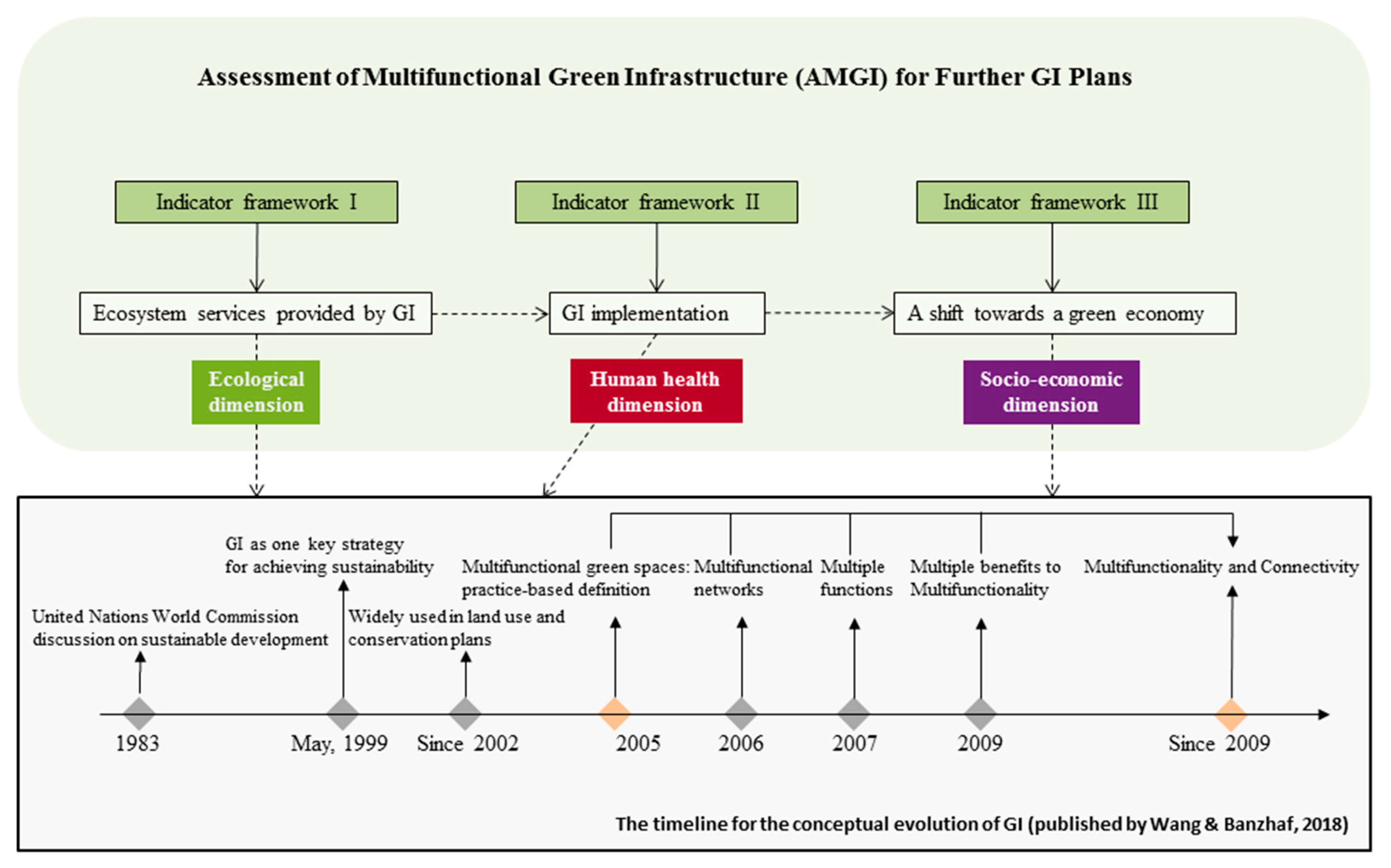
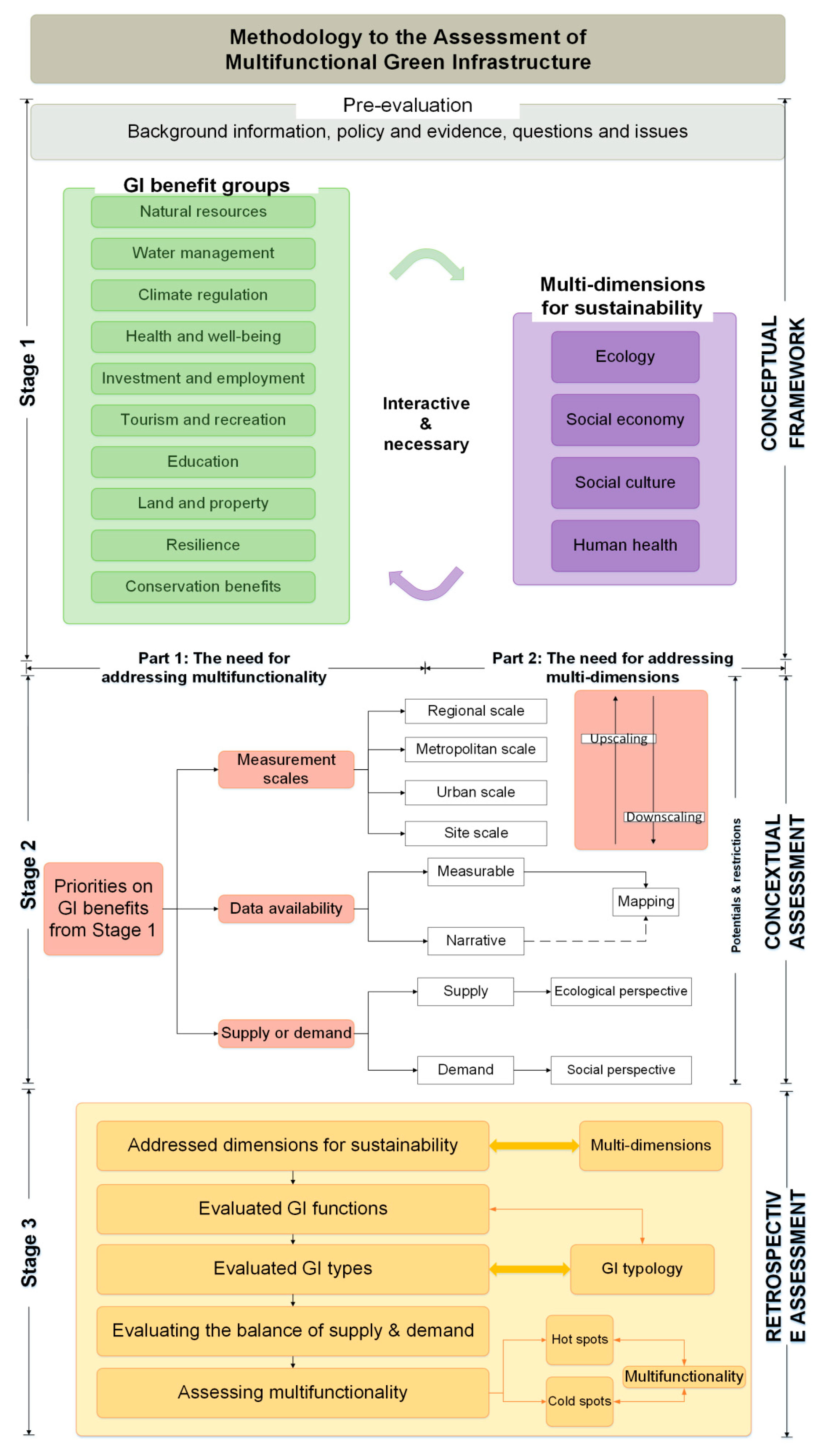
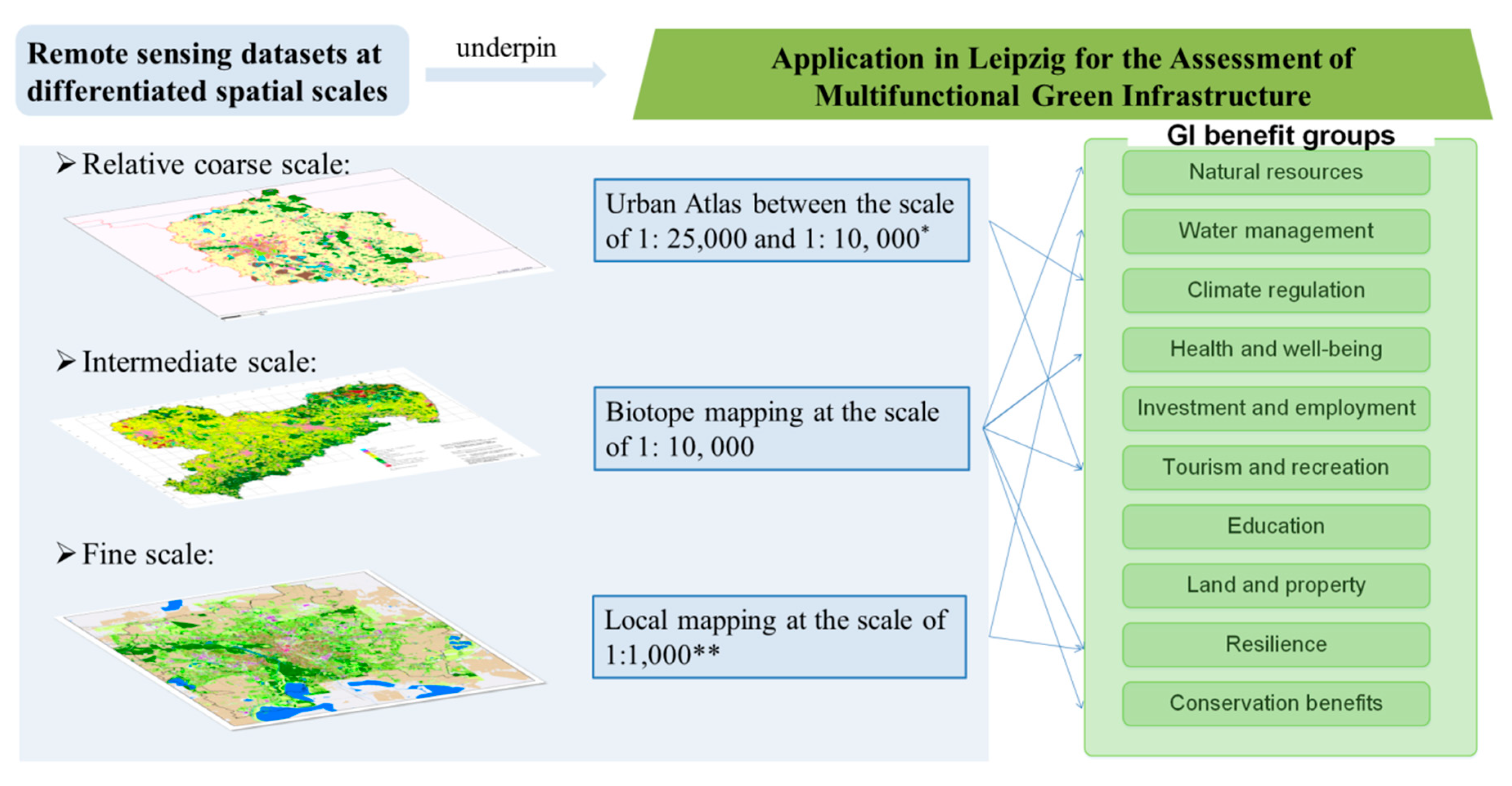
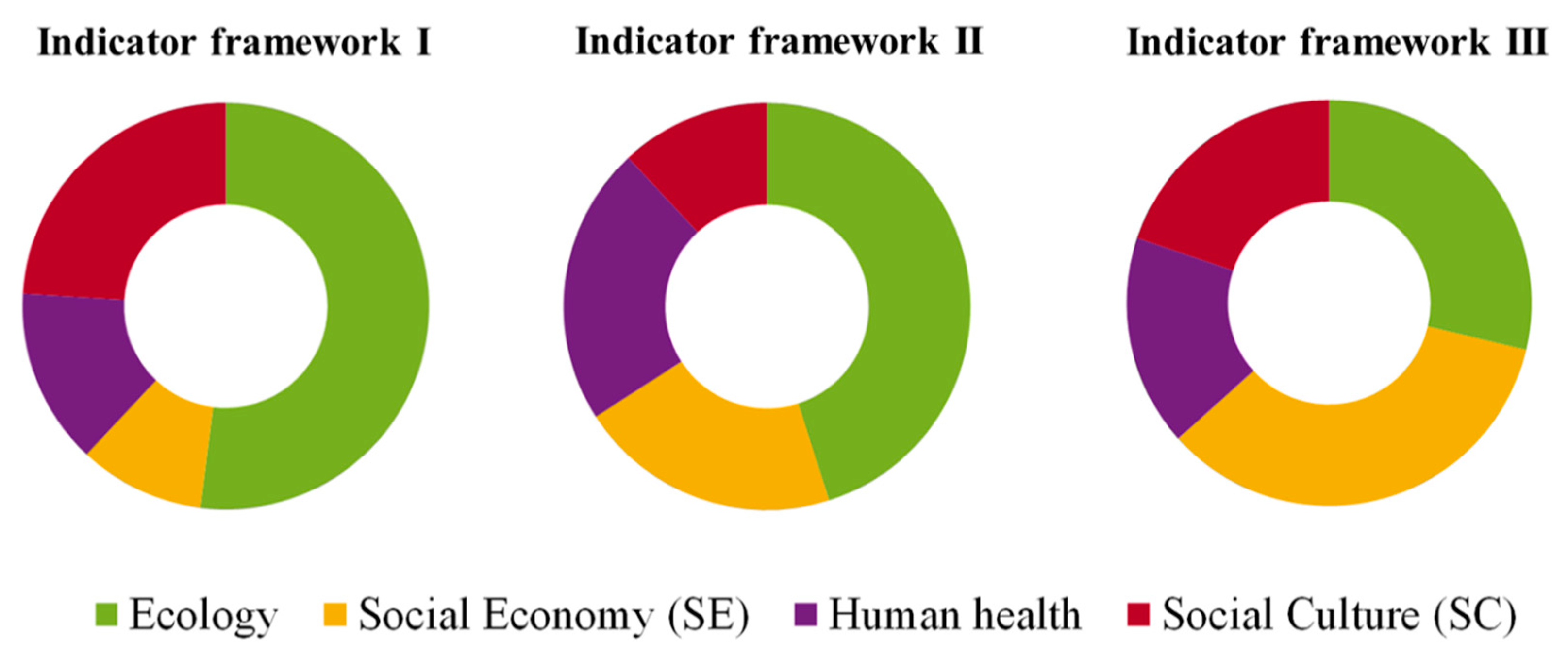
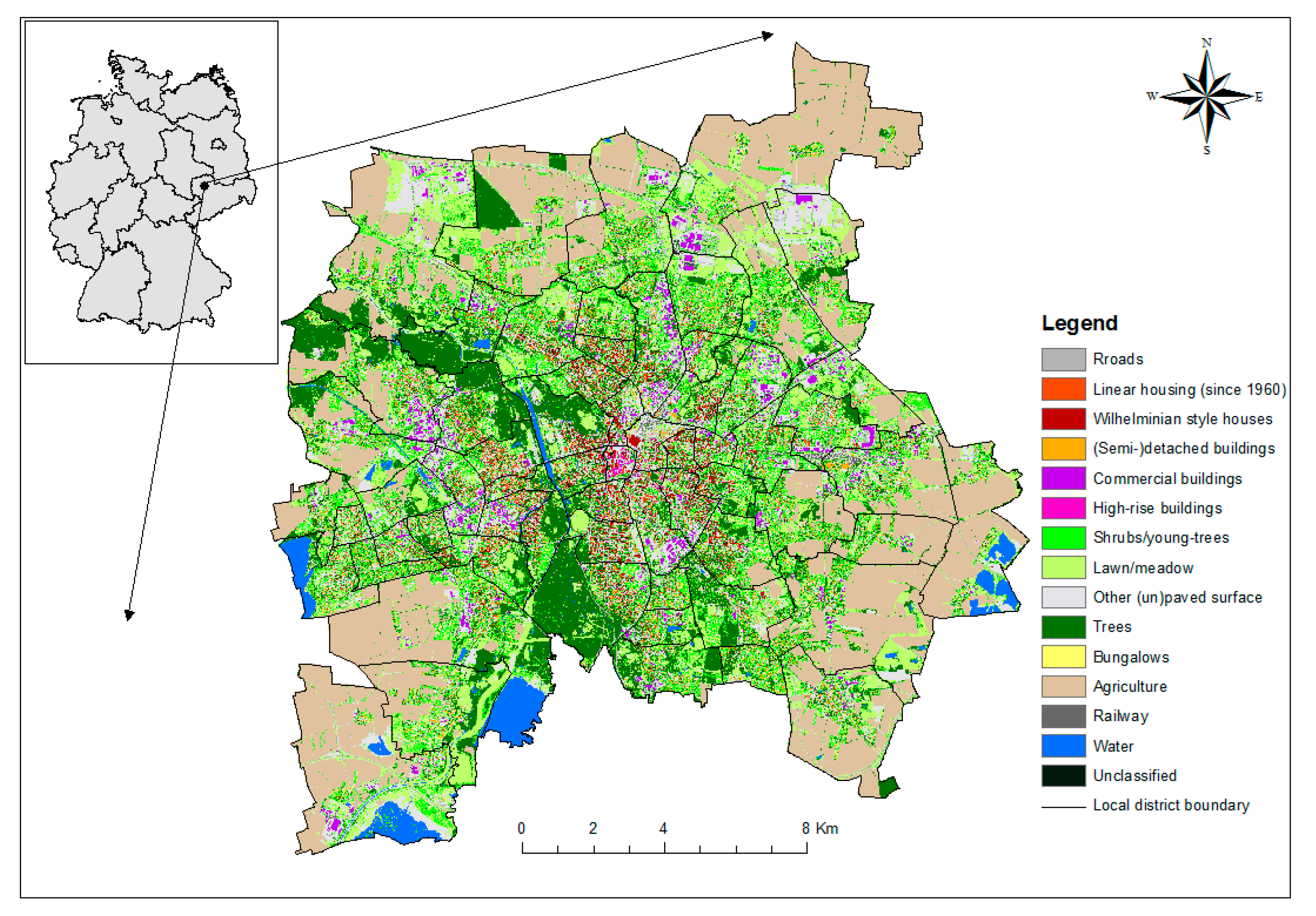
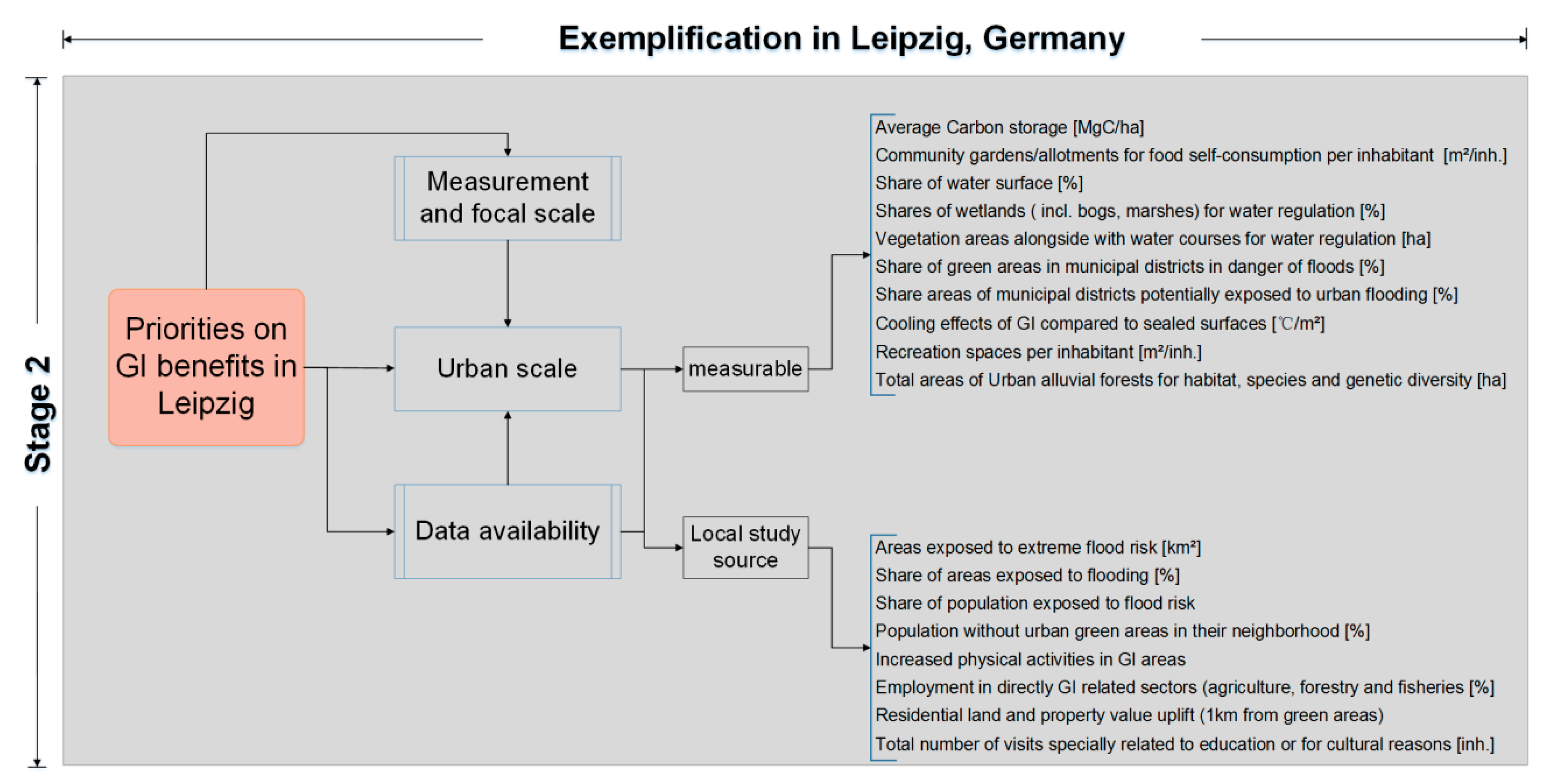
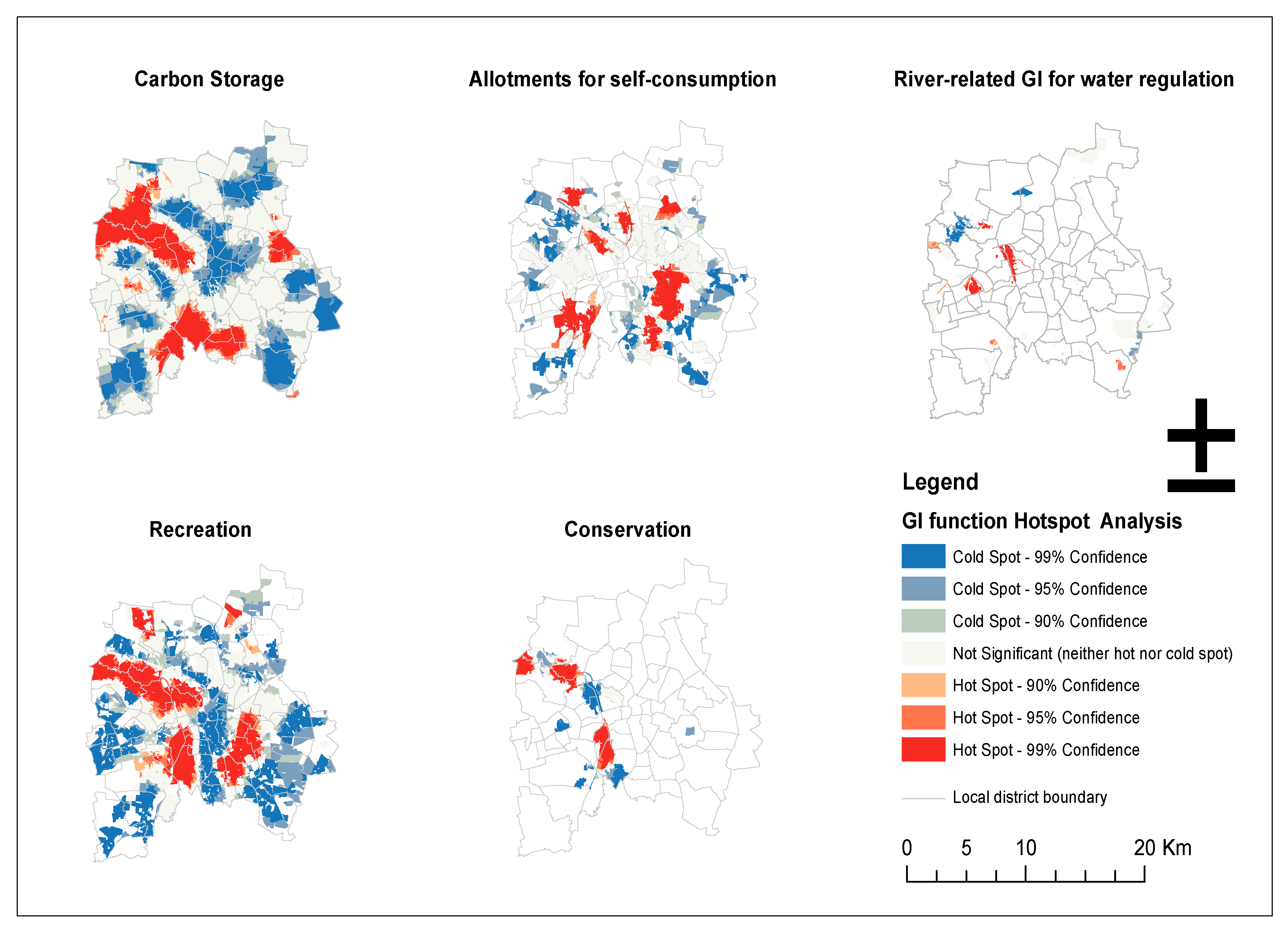

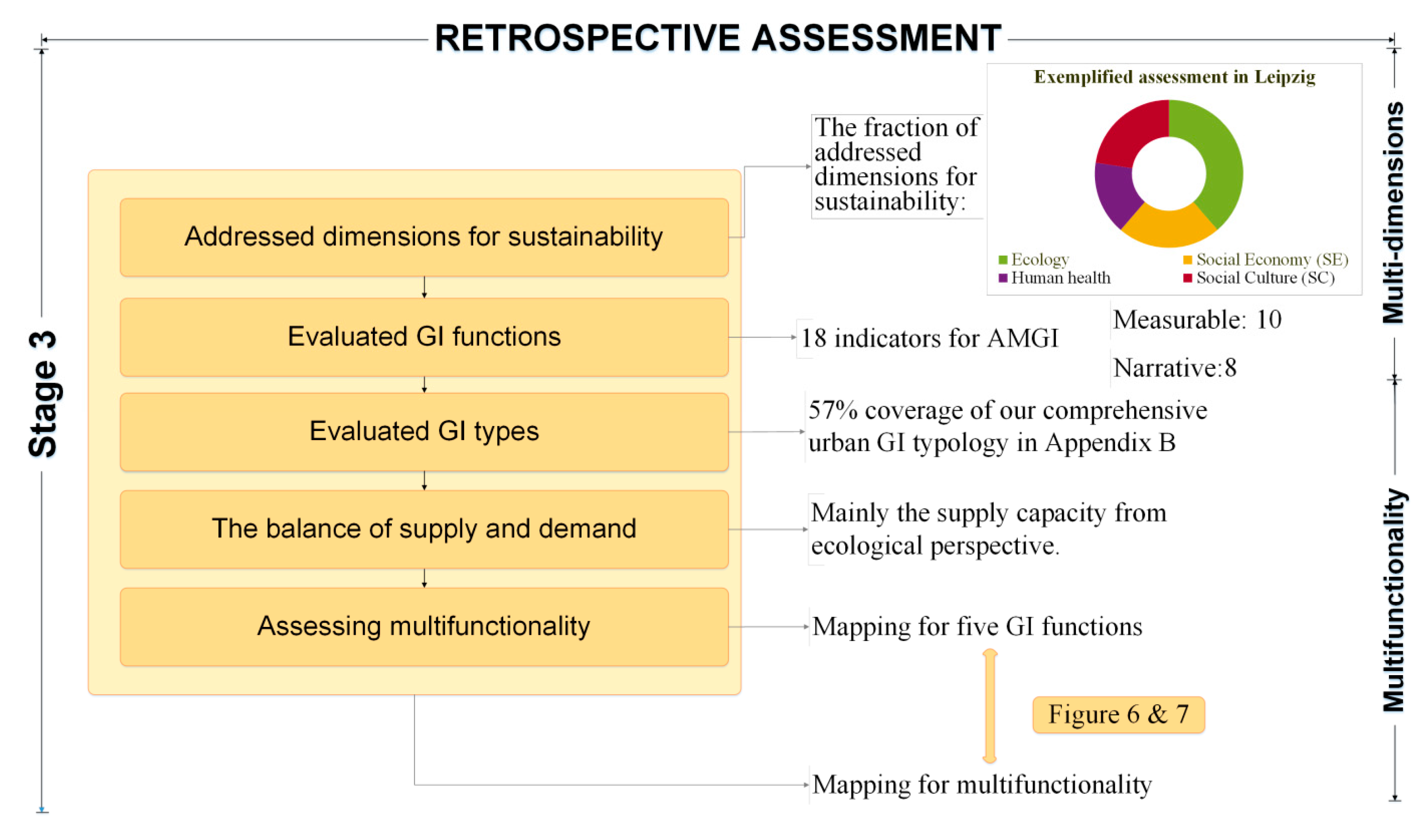
| MAES Classes | GI Benefit Groups | Indicator Codes from Indicator Framework I |
|---|---|---|
| Provision | Natural resources | 01, 02, 05, 28, 29 |
| Water management | 03, 04, 06 | |
| Regulation and maintenance | Climate regulation | 07, 08, 10 to 16, 18, 20, 21 |
| Health and well-being * | 09, 17, 19, 26 | |
| Resilience | 22, 23, 24, 25, 27 | |
| Cultural | Tourism and recreation | 30 to 38 |
| Education | 39 | |
| Conservation benefits | 40 |
| Indicator & Unit | Data Base | Data Type | Method/Source | Values |
|---|---|---|---|---|
| Average Carbon storage (MgC/ha) | Biotope mapping | Polygon | Analysis and extraction from Strohbach and Haase (2012) [67], and Derkzen et al. (2015) [68] | 11.80 |
| Community gardens/allotments for food self-consumption per inhabitant (m2/inhabitant (inh.). ) | Biotope mapping | Polygon | Calculation and aggregation * | 28.20 |
| Share of water surface (%) | Local Land Use and Cover map | Polygon | Calculation and aggregation * | 2.50 |
| Shares of wetlands for water regulation (%) | Biotope mapping | Polygon | Calculation and aggregation * | 0.04 |
| Vegetation areas alongside with water courses for water regulation (ha) | Biotope mapping | Polygon | Identification and calculation | 0.14 |
| Share of green areas in municipal districts in danger of floods (%) | Biotope mapping | Polygon | Calculation and aggregation | 56.65 |
| Share areas of municipal districts potentially exposed to urban flooding (%) | Biotope mapping | Polygon | Calculation and aggregation | 42.83 |
| Cooling effects of GI compared to sealed surfaces (°C/m2) | Urban Atlas | Raster | Analysis and extraction from Schwarz et al. (2012) [65] | 0.25 |
| Recreation spaces per inhabitant (m2/inh.) | Biotope mapping | Polygon | Calculation and aggregation * | 69.51 |
| Total areas of urban alluvial forests for habitat, species and genetic diversity (ha) | Biotope mapping | Polygon | Identification and calculation * | 1033.00 |
| Areas exposed to extreme flood risk (km2) | Local case study | - | Data from Kubal et al. (2009) [70] | 45.00 |
| Share of areas exposed to flooding (%) | Local case study | Polygon | Data from Kubal et al. (2009) [70] | 8.00 |
| Share of population exposed to flood risk | Biotope mapping | Polygon | Calculation and aggregation | 46.18 |
| Population without urban green spaces in their neighborhood (%) | Urban Atlas, | Polygon | Method newly introduced by Poelman [64] | 2.37 |
| Increased physical activities in GI areas | Field surveys | Point | Observation and survey | N/A |
| Employment in directly GI related sectors (agriculture, forestry, and fisheries (%) | Sachsen Statistics [71] | - | Statistik der Bundesagentur für Arbeit [72] | 13.70 |
| Residential land and property increment value (1 km from green areas) | Wohnungsbörse Leipzig [73] | - | Literature [74] | N/A |
| Total number of visits specially related to education or for cultural reasons (inh.) | Statistics | - | Literature | N/A |
© 2019 by the authors. Licensee MDPI, Basel, Switzerland. This article is an open access article distributed under the terms and conditions of the Creative Commons Attribution (CC BY) license (http://creativecommons.org/licenses/by/4.0/).
Share and Cite
Wang, J.; Pauleit, S.; Banzhaf, E. An Integrated Indicator Framework for the Assessment of Multifunctional Green Infrastructure—Exemplified in a European City. Remote Sens. 2019, 11, 1869. https://doi.org/10.3390/rs11161869
Wang J, Pauleit S, Banzhaf E. An Integrated Indicator Framework for the Assessment of Multifunctional Green Infrastructure—Exemplified in a European City. Remote Sensing. 2019; 11(16):1869. https://doi.org/10.3390/rs11161869
Chicago/Turabian StyleWang, Jingxia, Stephan Pauleit, and Ellen Banzhaf. 2019. "An Integrated Indicator Framework for the Assessment of Multifunctional Green Infrastructure—Exemplified in a European City" Remote Sensing 11, no. 16: 1869. https://doi.org/10.3390/rs11161869
APA StyleWang, J., Pauleit, S., & Banzhaf, E. (2019). An Integrated Indicator Framework for the Assessment of Multifunctional Green Infrastructure—Exemplified in a European City. Remote Sensing, 11(16), 1869. https://doi.org/10.3390/rs11161869




